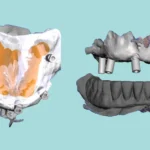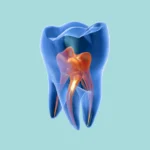Let’s be honest, almost every dentist working in fixed prosthodontics has encountered this exact scenario. A patient has lost their first molar, and the second molar behind it has drifted and tilted mesially. Now, the patient walks in, looking for a simple, quick fix: “Just give me a bridge, doctor.”
And this is where the internal debate often begins. Should you just go ahead and do the bridge to accommodate the patient? Or will this specific tilt inevitably lead to problems down the line? If so, what exactly are these problems? And is there a specific measurement of tilt beyond which you must tell the patient, “No, that’s simply not an option”?
In this article, we’re going to clarify everything. We’ll delve into both the scientific and practical aspects. We’ll pinpoint the maximum acceptable angulation for a tilted abutment tooth, explore the potential catastrophes that can occur if we ignore this inclination, and reveal the clever solutions at our disposal for managing such challenging situations.
The Magic Number: Is There Really a Maximum Tilt Angle? (The 25-Degree Rule)
Let’s kick things off with the most pressing question. Is there a scientific number we can actually rely on?
The answer is a resounding yes.
Most academic references and textbooks—chief among them Shillingburg’s work, often considered the “bible” of fixed prosthodontics—state that the maximum acceptable angle of divergence between abutment teeth is 25 degrees (1).
But why specifically 25 degrees?
The entire secret lies in a concept called the “Common Path of Insertion.” Imagine you’re constructing a building with two primary support columns. Would you ever expect a perfectly vertical column and another tilted one right next to it to easily support a roof that would descend and sit stably? It’s simply impossible.
The exact same principle applies to a dental bridge. There must be one imaginary path along which you can seat the bridge onto both teeth simultaneously, without it binding or getting stuck in any direction. If the tilt of the teeth exceeds 25 degrees, it becomes almost impossible to find this common path of insertion without making significant compromises elsewhere.
How Do I Measure This Angle in the Clinic?
It’s quite straightforward and doesn’t require any complex tools. Simply look at a clear periapical or bitewing radiograph. Draw a line representing the long axis of the tilted tooth and another line representing the long axis of the healthy tooth (or your desired path of insertion). Measure the angle between these two lines. This will give you an excellent approximation of the magnitude of the problem you’re dealing with.
The Hidden Disasters: What Happens When We Ignore Severe Tilting?
So, what exactly happens if a clinician decides to “shrug off” the severe tilt and proceeds with a bridge on a tooth angled at 30 or 40 degrees? This is where a cascade of problems begins, almost guaranteeing restoration failure in either the short or long term.
1. Excessive Tooth Reduction and Structural Damage
To achieve a common path of insertion and seat the bridge on these significantly tilted teeth, you’ll find yourself forced to perform excessive tooth reduction. Specifically, you’ll remove a considerable amount of tooth structure from the mesial surface of the tilted posterior tooth and the distal surface of the anterior tooth.
The Result? A very high probability of pulp exposure, which then necessitates an endodontic treatment that was initially avoidable. Beyond that, you significantly weaken the tooth, rendering it much more susceptible to fracture.
2. Destructive Non-Axial Forces on the Roots
This is arguably the most insidious long-term problem. Natural teeth are biologically designed to withstand occlusal forces that are directed along their long axis—axial forces. When a bridge is placed on a severely tilted tooth, these masticatory forces are unfortunately transformed into destructive, non-axial forces.
The Result? The bridge begins to act as a “lever,” which progressively causes the tilted tooth to become even more mobile. These detrimental forces exert immense pressure on the periodontal ligament and the surrounding bone, inevitably leading to bone resorption, increased tooth mobility, and ultimately, the loss of the abutment tooth itself (2).
3. Compromised Pontic and Gingival Issues
Severe tilting directly “steals” from the available space for the pontic (the artificial tooth).
The Result? You’ll find yourself fabricating a pontic that is small and inherently weak, with connectors linking it to the crowns that are frail and prone to fracture. Furthermore, the esthetics of such an artificial tooth are often compromised, and it creates an unavoidable food trap beneath the bridge, leading to chronic gingival inflammation.
Smart Solutions: How to Manage a Tilted Tooth?
Okay, we’ve thoroughly identified the problem. Now, what intelligent solutions are at our disposal?
The First and Most Ideal Solution: Orthodontic Uprighting
From a scientific and biological perspective, this is the gold standard solution. In essence, you refer the case to an orthodontist who can meticulously upright the tilted tooth, restoring it to its ideal anatomical position.
Pros: It completely preserves the tooth structure, ensures healthy axial occlusal forces, and sets the stage for an ideal bridge with minimal necessary tooth reduction.
Cons: It requires more time, incurs higher costs, and many patients unfortunately decline this option.
Second Solution: Prosthodontic Creative Approaches
If orthodontics isn’t a viable option, there are other solutions within prosthodontics itself. However, these demand exceptional precision and expertise from both you and your dental lab.
-
Non-rigid Connectors: This is a classic and very clever solution. The core idea is to fabricate the bridge in two separate segments instead of one solid piece. One segment is cemented onto an abutment tooth, and the second segment attaches to the other abutment, featuring a key that slides into a keyway on the first segment. This design ingeniously allows each part to be seated along a different path of insertion, significantly reducing stress on the tilted abutment (3).
-
Telescopic Crown: The concept here involves creating an “inner coping” on the tilted tooth. This coping effectively corrects the angulation, and then the final bridge seats precisely over this coping. Again, this is a complex solution that truly requires a highly skilled dental laboratory.
-
Elective Endodontics with Planned Preparation: This is a more “aggressive” and generally less favored solution. The idea is that you proactively decide to perform root canal treatment on the tilted tooth. This then grants you the freedom to reduce tooth structure significantly to achieve an ideal path of insertion without worrying about pulp exposure. The major drawback, however, is that you sacrifice the tooth’s vitality and inherently weaken it.
Third Solution: Think Outside the Bridge Box
Sometimes, the best solution is simply not to fabricate a bridge at all.
-
Dental Implant: This represents the modern standard of care. You place a dental implant in the site of the extracted tooth, thereby eliminating the need to touch any adjacent teeth whatsoever, whether they are tilted or perfectly aligned.
-
Removable Partial Denture: This is the most cost-effective and least invasive option. However, it naturally offers less patient comfort and stability compared to fixed solutions.
The Bottom Line: When Do You Say “No”?
The rule is quite simple, doctor. If the tilt of an abutment tooth will force you to compromise the tooth’s health or the fundamental principles of a successful restoration, then you absolutely must say no.
That 25-degree figure isn’t a rigid law; it’s a vital warning bell. If you find yourself approaching or exceeding it, you need to pause and critically consider all the potential problems we’ve discussed. Ignoring established biomechanical principles just to “get a case done” for a patient is a guaranteed recipe for failure that will inevitably resurface in your clinic within a year or two.
Making the right decision not only ensures the success of your restoration but also meticulously safeguards your reputation as a knowledgeable clinician who genuinely prioritizes the patient’s long-term well-being.





















